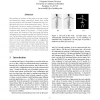ECAL
2007
Springer
14 years 6 months ago
2007
Springer
The human body has a complex skeleton, giving a very high number of degrees of freedom, and is actuated by a large number of elastic elements muscles and tendons. As a consequence,...
ACCV
2007
Springer
14 years 6 months ago
2007
Springer
This paper proposes a novel volume-based motion capture method using a bottom-up analysis of volume data and an example topology database of the human body. By using a two-step gra...
IROS
2007
IEEE
14 years 6 months ago
2007
IEEE
— A method for segmentation and recognition of human body behavior data is proposed. Recognition of human body movements is getting larger interests in robotic research field, s...
GLOBECOM
2007
IEEE
14 years 6 months ago
2007
IEEE
Abstract— A Wireless Mesh Network (WMN) is being considered for commercial use in spite of several unaddressed issues. In this paper we focus on one of the most critical issues: ...
AVSS
2007
IEEE
14 years 6 months ago
2007
IEEE
This paper presents a novel auto-calibration method from unconstrained human body motion. It relies on the underlying biomechanical constraints associated with human bipedal locom...
ICALT
2008
IEEE
14 years 6 months ago
2008
IEEE
Augmented Reality has been used for developing systems with learning purposes. In this paper, we present an Augmented Reality system for learning the interior of the human body. W...
COST
2009
Springer
14 years 6 months ago
2009
Springer
Human body images acquired at visible spectrum have inherent restrictions that hinder the performance of person recognition systems built using that kind of information (e.g. scene...
ECCV
2002
Springer
15 years 1 months ago
2002
Springer
The problem we consider in this paper is to take a single two-dimensional image containing a human body, locate the joint positions, and use these to estimate the body configurati...
CVPR
2004
IEEE
15 years 2 months ago
2004
IEEE
Recovering the 3D coordinates of various joints of the human body from an image is a critical first step for several model-based human tracking and optical motion capture systems....
CVPR
2000
IEEE
15 years 2 months ago
2000
IEEE
This paper describes a new method for tracking of a human body in 3D motion by using constraints imposed on the body from the scene. An image-based approach for tracking exclusive...





